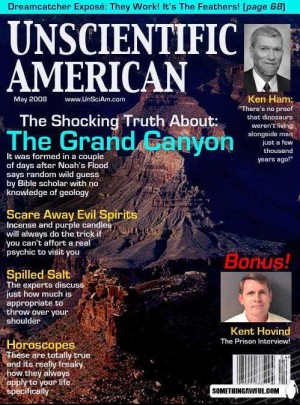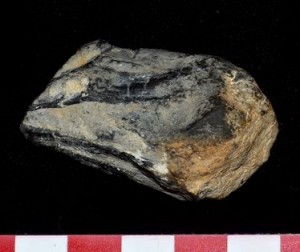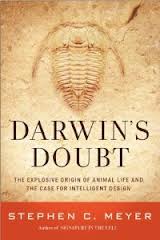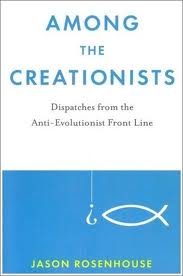
This week brings news from several different parts of the creationist battlefront. Even as Louisiana failed to overturn its recent law allowing the teaching of creationism in public schools (despite nationwide pressure led by student Zack Kopplin), there was some more revealing news from the two biggest creationist organizations in America:
1) In an earlier post, I discussed the decline in attendance and loss of money from Ken Ham’s “creation museum” in Kentucky. Now even they must pay attention to the problem, since the declining attendance has put a crimp in their budget and brought the fundraising for their “Ark encounter” to a standstill. Their problem, as I outlined before, is that their exhibit is 5 years old now and has not changed, so most of the local yokels who might want to visit it have done so. There’s no point to making the long trip and seeing the expensive “museum” again if there’s nothing new to see. (Unlike real science museums, which must change exhibits constantly not only to boost repeat attendance, but to reflect the changes in scientific thinking). As Mark Joseph Stern wrote on Slate.com:
There could be another explanation, though. A spectacle like the Creation Museum has a pretty limited audience. Sure, 46 percent of Americans profess to believe in creationism, but how many are enthusiastic enough to venture to Kentucky to spend nearly $30 per person to see a diorama of a little boy palling around with a vegetarian dinosaur? The museum’s target demographic might not be eager to lay down that much money: Belief in creationism correlates to less education, and less education correlates to lower income. Plus, there’s the possibility of just getting bored: After two pilgrimages to the museum, a family of four would have spent $260 to see the same human-made exhibits and Bible quote placards. Surely even the most devoted creationists would consider switching attractions for their next vacation. A visit to the Grand Canyon could potentially be much cheaper—even though it is tens of millions of years old.
So how did they deal with the attendance dilemma? Did they open some new galleries with “latest breakthroughs in creation research”? (No, that’s not possible because they don’t do research or learn anything new). No, they opted for the cheap and silly: make it into an amusement park with zip lines. Apparently, flying through the air for a few seconds suspended from a cable is the latest fad in amusements, so the Creation “Museum” has to have one to draw the crowds—and hope they can suck in a few visitors to blow $30 a head or more to see their stale old exhibits as well. Expect that by next year they’ll be a full-fledged amusement park with roller coasters and Tilt-a-whirls, just like so many other “Biblelands” do across the Deep South.
And what do ziplines have to do with creationism? As usual, they have a glib and non-responsive answer:
Zovath’s response to the museums critics who wonder how zip lining fits with their message?
“No matter what exhibit we add, the message stays the same,” Zovath said. “It’s all about God’s word and the authority of God’s word and showing that all of these things, whether it’s bugs, dinosaurs or dragons – it all fits with God’s word.”
I was hoping for something more imaginative and relevant, like “zip lines make you feel like an angel flying down from heaven.”
2) Our old friends at the Discovery Institute in Seattle (the main organization which once promoted the “intelligent design” argument until it died in court in 2005) are doing some very shady fundraising and bookkeeping. Their site is constantly beating the bushes to get religionists to contribute to them, and they have extensive funding from a number of right-wing foundations that want to promote religion in public society and get around the 1st Amendment separation of church and state. They have a budget that is ten times the size of what their main opponent, the tiny National Center for Science Education, has to spend. They claim to be a tax-exempt non-profit, yet they also claim not to be a religious organization.
So on what basis are they tax exempt? Are they really a charity which spends most of its funds on social welfare? The website Cenlamar.com dug into the 990 tax forms for the Discovery Institute, and found some remarkable things. Almost 90% of the money they raise goes to salaries of their “research fellows,” plus lawyers, lobbyists, administrators, overhead, and expenses. No more than 13% could go to what could charitably be called “research,” although they don’t actually publish ANY peer-reviewed research, only stuff for their own house journals, and PR documents to push their cause. As their founding document, the “Wedge Strategy”, pointed out at the beginning, their motive isn’t to discover new science; it is conduct a PR campaign to get their viewpoint equal time in public schools and elsewhere in the media and public discourse, and skip the hard, complicated process of doing the scientific research that might support their position. As Cenlamar.com points out, however, 90% spending on overhead and salaries is WAY out of line for a non-profit charity. By contrast, organizations like the BBB Wise Giving Allowance or American Institute of Philanthropy spend no more than 35-40% on the same thing, and the United Way spends only 20%. This is typical of most non-profit charities, and clearly the Discovery Institute is not following the normal guidelines for non-profts.
So how do they get away with it? They use a clever sleight-of-hand to dodge the IRS guidelines for tax-exempt charities. They make “grants” to something called the “Biologic Institute”, which is a wholly-owned subsidiary of the Discovery Institute. Then the Biologic Institute spends this “grant” money for more salaries and overhead. Even though they claim to the IRS that they are funding grants, they are essentially sending the grant money to themselves to dodge the tax structure. I’m not familiar with the tax laws, but this sounds like a pretty shady deal which clearly violates the spirit if not the letter of the tax laws. As Cenlamar.com shows, it’s a “con-profit”, not a real non-profit. It’s a great con job which allows them to essentially spend all their money on their PR campaign and their staffers, with no obligation to do actual research, or to send money outside their own building.
So much for the honesty of these “Christian” creationists….
comments (15)








